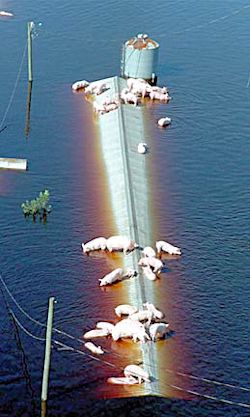Last of two parts
 Hogs find refuge on a roof after Hurricane Floyd. Photo: AP |
One of the more striking horrors of Hurricane Floyd’s insidious floodwaters was illustrated in graphic photographs of dead animals. Millions and millions of drowned turkeys, chickens and pigs littered the landscape of coastal North Carolina.
Supporter Spotlight
Bloated corpses lined riverbanks and floated on top of putrid stews of diluted pollutants that lingered for weeks after the storm. One photograph reportedly showed a shark munching on a pig carcass, and there were unconfirmed reports of pig bodies bobbing in the ocean.
But it was the description of the overflowing hog lagoons – large open pits brimming with a thick slurry of pig manure – that many viewed as an especially offensive environmental disaster. National news reports detailed the dire consequences of tons of fecal matter flowing into waterways, seeping into surface and groundwater and polluting drinking water.
Responding to widespread public disgust, state officials promised to shut down the lagoons. Lawsuits were filed. An enormous scientific study was done on alternative ways to dispose of hog waste. A report filled with detailed recommendations and cost estimates was issued.
Fifteen years after dozens of hog lagoons spilled their noxious contents over thousands of acres of private and public lands and into the watersheds of four rivers that feed the second-largest estuary system in the nation, open lagoons filled with pig waste still sit exposed on acre after acre of flat lands in coastal North Carolina.
“You would think as a result of Floyd that major changes would have been made,” said Rick Dove, the retired Neuse Riverkeeper who is now an associate with the Waterkeeper Alliance and has remained a relentless watchdog of the swine industry for the last 20 years. “I regret to inform you, they have not.”
Supporter Spotlight
Dove has taken thousands of aerial photographs and videos over the years to document the practices and violations in the production farms.
Not only have few improvements been made, he said, there are now huge turkey and chicken operations built next to some of the hog farms. With about 2,300 industrial hog operations, North Carolina is one of the top producers of pigs in the world.
In the arcane but precise language of permits these places are known as “CAFOs” for Concentrated Animal Feeding Operations. A few were shut down after Floyd, Dove said. And new or expanded facilities are not permitted by law. But the technology used to dispose of the waste from the estimated 8 million hogs at N.C. facilities, he said, remains essentially what it was when Floyd flooded the lagoons.
 Rick Dove |
“It’s really this open cesspool,” he said. “Basically, it’s outhouse technology. That’s really the problem.”
The hog feces and urine drop through slats in the floor, where it is eventually flushed into open pits, euphemistically called lagoons. The untreated waste slurry is periodically pumped out and sprayed on fields.
Consumer and environmental groups contend that the practice pollutes the air and land to the point where nearby residents suffer health problems. Residue from the spray has coated grasses and trees in yards and permeates homes.
In an online video recorded in 2013, members of the Rural Empowerment Association for Community Help, or REACH, in Duplin County, the home of the largest number of hog operations in the state, described how people in the community have suffered burning eyes and respiratory sickness, and complain that they can’t go outside for cookouts or even hang their laundry because the odor and residue is so wretched.
Manure pits have been known to emit hydrogen sulfide, a gas that can lead to flu-like symptoms and even brain damage, according to the Natural Resources Defense Council.
The pig waste also contains myriad toxins, viruses and bacteria.
According to information provided in an e-mail by N.C. Pork Council CEO Deborah Johnson, the industry produced $2.55 billion in farm income in 2012 – about 22 percent of all farm income in the state. The total economic impact of the pork industry in the state is estimated at $9 billion.
There are about 2,100 permitted farms in the state with more than 250 head of swine, the statement said. About 50 permitted hog farms in eastern North Carolina were flooded in Floyd, but about 98 percent of the others in operation did not flood.
 The satellite photo shows the plumes of sediment flowing into Pamlico Sound after Hurricane Floyd, raising fears about what would happen to water quality and fisheries in the sound. Photo: NASA |
“Of those impacted,” Johnson said, “the majority were cases in which the waters of the state inundated the lagoons on the farms.”
A Nov. 1999 conservation easement program to acquire swine operations in the flood plain resulted in the closure of 103 animal waste lagoons, the statement said.
Floyd killed 52 people in the state, most of them from drowning. It also caused $6 billion in property damage and about $1 billion in agricultural losses.
In a Jan. 2006 settlement between the Waterkeeper Alliance and Smithfield Foods – now owned by a Chinese corporation – the pork producer agreed to improve its waste-management systems at about 275 of its farms in North Carolina.
And six years before, then-North Carolina Attorney General Mike Easley reached an agreement with Smithfield Foods to eliminate open-air lagoons and spray field systems on about 170 company-owned farms within five years.
Under the agreement, Smithfield, then the largest hog producer in the world, was to provide $15 million to N.C. State University to fund a study of alternative waste treatments for commercial hog operations. After a suitable alternative that met environmental and economic standards was determined, the company would convert to the improved technology within three years.
Implementation and enforcement of the agreement, however, depended on follow-through by Easley’s successors.
“Things have not changed at all,” said Larry Baldwin, the Waterkeeper Alliance’s CAFO coordinator.
 Joe Ramus |
But Michael Williams, professor of poultry science at N.C. State, said that there have been improvements, most notably in management of the liquid levels in the lagoons.
Despite the perception that the waste lagoons are filled with raw fecal matter, he said that they are designed as biological systems that break down the waste. Even so, he said, they still hold exposed waste and are vulnerable to floods.
Williams was a lead scientist involved in the comprehensive 3- to 5-year study, which resulted in a several thousand-page report and about 100 different proposed alternatives. Eventually, the alternatives were narrowed down to about 15 that were tested on the ground and had acceptable environmental performance standards.
But the industry found the improvements too expensive to be feasible, he said.
Williams said that he is optimistic that some of the measures will be able to be incorporated in the near future, especially if the state’s renewable energy credits make it worthwhile for the industry to reuse the waste in environmentally sound ways.
“My hope is, in the future, an alternative can be developed where it makes good business sense,” Williams said. “This is a very complex issue, scientifically, politically and socially.”
Meanwhile, it is a mystery exactly what the impacts of Floyd were to the environment, especially the Pamlico Sound.
Another compelling aerial image of post-Floyd impacts was an enormous dark-colored plume of water that moved from the inland floods into the Pamlico Sound.
Many biologists and environmental scientists were worried that the massive volume of polluted freshwater would cause vast fish kills and ruin the commercial fishing industry.
But to the surprise of many, not only were there no fish kills, some fishing was the best in years, apparently because the fish fled ahead of the freshwater deluge.
Although the ominous plume was the right unhealthy color, it carried a lot more than hog manure, said Joseph S. Ramus, professor emeritus at Duke Marine Lab.
“It was coming out of the watersheds,” he said. “There was a lot of organic matter – the material that was deposited in the margins of the water systems.”
Ramus was one of the scientists who had been studying the Pamlico before the storm. He said that the chemical and phytoplankton environment in the sound recovered in about four months after the storm. The fisheries – which were studied by another scientist – took much longer.
“The system is quite resilient,” he said.
But no measurements were taken before or after the storm, Ramus said, so it’s impossible to really understand the environmental impact of Floyd. Simply put, he said, no one wants to provide funding for long-term environmental studies.
“There’s no data,” he said. “There’s a temporal mismatch between science funding and things that go on in natural systems.”








